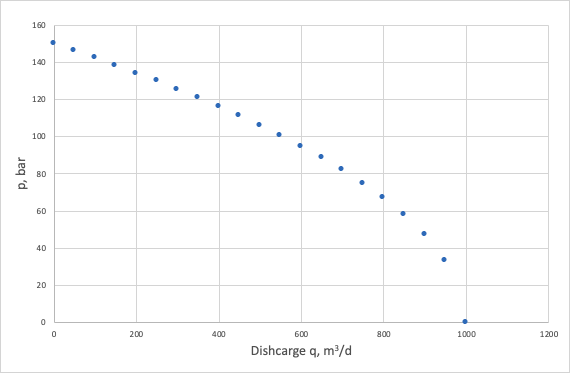The most general Pump model is given as a function of the mass flowrate on the intake p_{\rm in} and discharge pressure p_{\rm out}:
| (1) | \dot m = M(p_{\rm out}, p_{\rm in}) |
It's often presented in terms of intake volumetric flowrate:
| (2) | q = q_{in} = \frac{\dot m}{\rho(p_{in})} = \frac{M(p_{\rm out}, p_{\rm in})}{\rho(p_{in})} |
where
\rho(p) | fluid density as a function of fluid pressure p |
The electrical power consumption
\displaystyle W = \frac{dE}{dt} is given by:
| (3) | W = \eta(q) \cdot q \cdot (p_{\rm out}-p_{\rm in}) |
where
\eta | pump efficiency |
In most practical cases the pump model
(2) depends on the difference between intake and discharge pressure
p_{\rm out} - p_{\rm in} and called Pump Characteristic Curve (see Fig. 1):
| (4) | q = q(p_{\rm out} - p_{\rm in}) |
Fig. 1. Example of Pump Characteristic Curve. |
A popular pump proxy model is given by the quadratic equation:
|
|
| (7) | \eta(q) = 4 \, \eta_{\rm max} \cdot q/q_{\rm max} \cdot ( 1 - q/q_{\rm max}) |
where
\delta p_{\rm max} | maximum pressure gain that pump can exert over the input pressure p_{\rm in} |
|---|---|
q_{\rm max} | maximum flowrate that pump can produce |
k_f \in [0,1] | total hydraulic pump friction (dimensionless) |
\eta | pump efficiency |
\eta_{\rm max} | maximum pump efficiency |
Many pumps can be normally adjusted by the variation of the working frequency which affects the maximum pump flowrate and maximum pressure gain as:
|
|
where
q_{\rm max} | maximum intake flowrate at the working frequency f | \delta p_{\rm max} | maximum pressure gain at the working frequency f | f | adjusted working frequency |
q^*_{\rm max} | maximum intake flowrate at the nominal frequency f^* | \delta p^*_{\rm max} | maximum pressure gain at the nominal frequency f^* | f^* | nominal frequency |
See also
Natural Science / Engineering / Device / Pump
Physics / Fluid Dynamics / Pipe Flow Dynamics / Pipe Flow Simulation (PFS)
